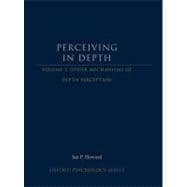
Note: Supplemental materials are not guaranteed with Rental or Used book purchases.
Purchase Benefits
Looking to rent a book? Rent Perceiving in Depth, Volume 3 Other Mechanisms of Depth Perception [ISBN: 9780199764167] for the semester, quarter, and short term or search our site for other textbooks by Howard, Ian P.. Renting a textbook can save you up to 90% from the cost of buying.
| Contents of Volume 3 | |
| Depth from accommodation and vergence | |
| Depth from perspective | |
| Depth from interposition and shading | |
| Depth from motion parallax | |
| Constancies in visual depth perception | |
| Interactions between visual depth cues | |
| Seeing motion-in-depth | |
| Pathology of visual depth perception | |
| Visual depth perception in the animal kingdom | |
| Reaching and moving in 3-D space | |
| Auditory distance perception | |
| Electrolocation and thermal senses | |
| Animal navigation | |
| Final word | |
| References | |
| Subject index | |
| Portrait index | |
| Index of cited journals | |
| Table of Contents provided by Publisher. All Rights Reserved. |
The New copy of this book will include any supplemental materials advertised. Please check the title of the book to determine if it should include any access cards, study guides, lab manuals, CDs, etc.
The Used, Rental and eBook copies of this book are not guaranteed to include any supplemental materials. Typically, only the book itself is included. This is true even if the title states it includes any access cards, study guides, lab manuals, CDs, etc.